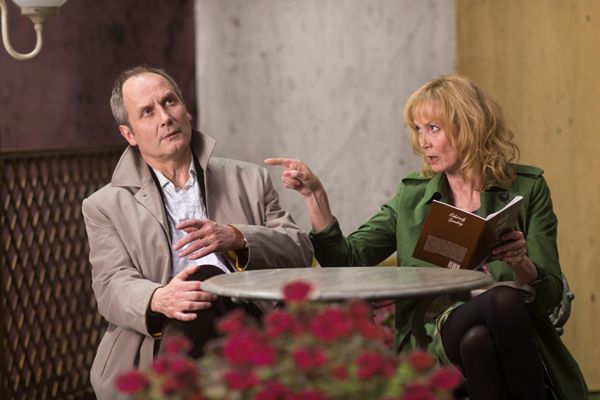Eye For Film >> Movies >> Life Of Riley (2014) Film Review
Life Of Riley
Reviewed by: Amber Wilkinson

Alain Resnais's final film, which won a Berlin Film Festival award for innovation less than a month before the death of the 91-year-old earlier this year is his third adaptation of an Alan Ayckbourn play, following Smoking/No Smoking and Private Fears In Public Places. As such, anyone who has seen more than a couple of the prolific British playwright's 78 works will pretty much know what to expect here in plot terms - this is middle England in middle age and midlife crisis, although on this occasion the results are disappointingly middling.
Resnais embraces theatrical artifice. All the world - or at least this bit of Yorkshire - is a stage, with rudimentary sets, featuring lights often switched on by the cast, leaving Ayckbourn's words no place to hide, a problem given their lack of weight. Yorkshire itself is used to set the scene only in second unit footage, which meanders down the lanes of the county in its various seasons. Punctuating the action are pen and ink drawings of each couple's home, emphasising their status - from grandeur to suburbia - but also giving a curious British sitcom air to events.

The sitcom vibe is underlined by the set-up - three couples and their good friend George, who also happens to be terminally ill and kept offstage for the entire film. For Ayckbourn, marriages grown long are difficult and these are no exception, as George - drawn as a happy-go-luck, forever young playboy by his friends - acts as a catalyst for each couple's fears. The most succesful theme turns out not to be the relationship traumas but the notion of time itself, exemplified by clocks in one couple's home that are perpetually wrong, despite the husband's feverish clock-watching.
Ayckbourn deploys the device of a play within a play - his own first hit Relatively Speaking - and Resnais continues the Russian doll theme, wrapping his film around the enterprise and yet resolutely sticking to a deliberately stagey staging. Ayckbourn's play itself, suffers from focusing on device rather than depth of character, with the humour arch at best, a situation unfortunately magnified by Resnais' formal challenge.
The director is determined that we won't 'get used to it', throwing in moments in which a character is simply picked out against a background of black and white cross-hatching, which put me unfortunately in mind of a Bunty comic, and even resorting to the gleeful burrowings of an animatronic mole in order to throw us out of the action. If the characters are focused on how and if, for us the question why lingers in the air. Why be formally challenging if it doesn't underline the film's themes beyond the basic suggestion that we all 'play versions of ourselves'? Why emphasise the acting to the point of distraction? "Play, pause, rewind, fast-forward, that's not life." Nor is this.
Reviewed on: 12 Nov 2014


















